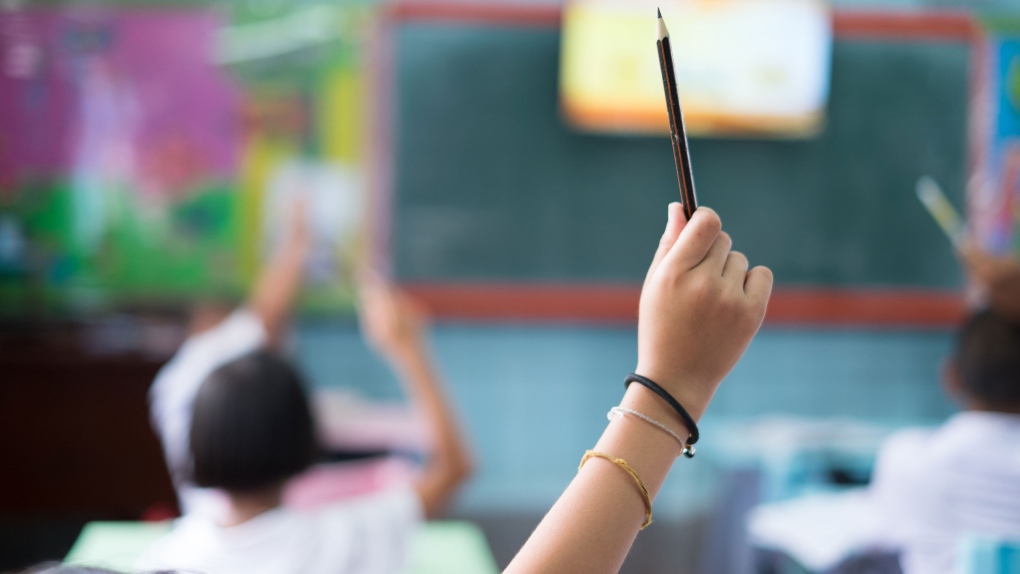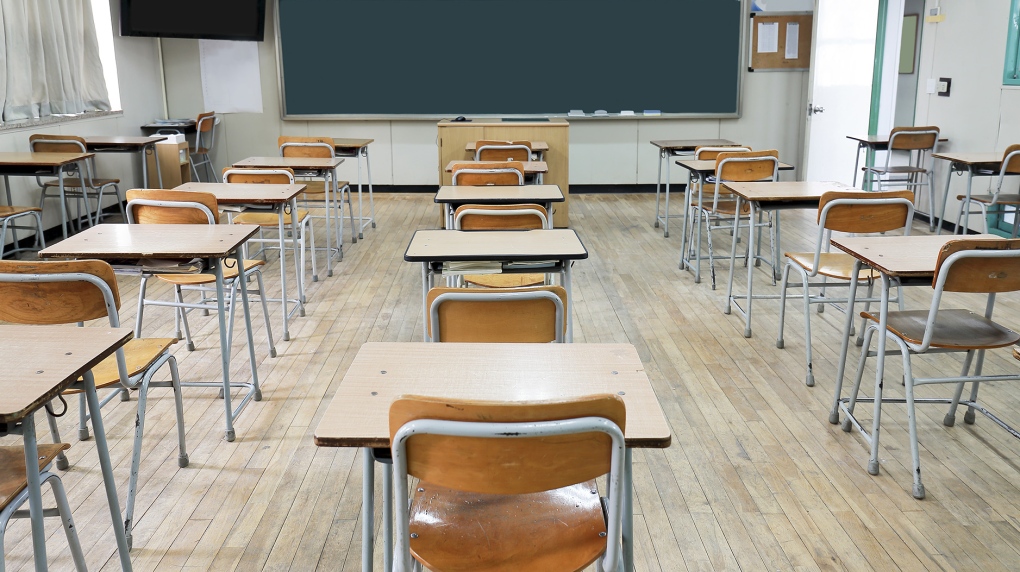New Ontario Catholic curriculum homophobic and transphobic, advocates say
 Children raise their hand in a classroom. (Narongchai Hlawprasert/Adobe Stock Photo/CNN)
Children raise their hand in a classroom. (Narongchai Hlawprasert/Adobe Stock Photo/CNN)
Advocates warn a new Ontario Catholic school curriculum for family life education, set to be taught in the fall, has homophobic and transphobic undertones.
“It's a really concerning curriculum,” Kyle Iannuzzi, a member of the 2SLBGTQ+ Advisory Committee within the Toronto Catholic District School Board (TCDSB), told CTV News Toronto.
The new curriculum encompasses topics such as relationships, family structures, as well as sexual education and health. Of particular issue to Iannuzzi is the focus on marriage being an act between a man and a woman and that individuals live within their male and female body.
“While there might be a minor improvement, the curriculum reads to me like there's still going to be a big problem and nobody's thinking about it through the perspective of a sponge-like brain that's absorbing this information for the very first time.”
The Institute for Catholic Education (ICE) is responsible for creating a version of the public school curriculum that accommodates religious schools.
- Download our app to get local alerts on your device
- Get the latest local updates right to your inbox
The last time the family life education curriculum was updated was in 2012.
The change also comes amid accusations the textbook used to teach the 2012 curriculum, which was discontinued by the publisher early last year, was homophobic and transphobic.
Resources associated with the new curriculum are in development, but until then many Catholic schools are still using the “Fully Alive” texts.
Anne Jamieson, executive director of ICE, said in a statement that the new curriculum adheres to ministry of education expectations and “emphasizes that children in elementary school need gentle accompaniment in learning about family life.”
The curriculum also recognizes that views in secular society may differ from the traditional Catholic faith, Jamieson added.
“Our core teaching remains the same – every individual is a child of God, to be welcomed, and to be treated with love, respect, compassion and sensitivity.”
But advocates say not enough has changed from the previous curriculum to alleviate their concerns that LGBTQ2S+ students feel unwelcome within the public system.
WHAT IS IN THE CURRICULUM?
The new teachings–which at least two large school boards in Toronto have confirmed they plan to use—aim to meet the province’s health and physical education expectations.
An overview of the curriculum, posted to ICE’s website, talks about teaching family relationships, including marriage, as well as mental and sexual health.
Paolo De Buono, a former teacher within the TCDSB and founder of a group called Stop the Catholic Harm, told CTV News Toronto the new curriculum has undertones of homophobia and doesn’t meet the realities of the 21st century.
“The curriculum teaches the Catholic teaching of chastity,” De Buono said. “That's a coded word. Catholics who understand Catholic doctrine understand what that means. What that means is that if you're gay or lesbian, you can never have sexual relations. It's sinful to do so.”
“There is also an emphasis on this idea that we are only male or female as we were born…We don't have a body. We are a body. We are one thing. And in a sense, you can't separate sexual identity.”
The 76-page document provides an overall list of expectations for the curriculum, divided by grade.
As early as Grade 1, it’s expected that children “identify that humans are created male and female in God’s image.”
In Grade 3 students learn about marriage and how it is a “covenant of love between a man, woman and God.”
The new curriculum does mention civil marriage in Grade 6 and asks students to describe the similarities and differences compared to a marriage recognized by the church. It also asks students to “assess the effects of stereotypes and assumptions regarding age, colour, race, ethnicity, creed, ability, gender, sex, sexual orientation, and propose appropriate ways of responding and promoting the sacredness of life.”
In terms of sexual education, students between grades 1 and 8 are thought to identify parts of the body within the reproduction system, as well as learn about puberty and how abstinence is the healthiest option to prevent unwanted pregnancy.
“It's not a Health and Sciences curriculum. It's a religious curriculum, and that's a problem,” Iannuzzi said.
“The information that they're being told as ‘yeah, you can have a civil union outside of here, but the family that God values is one that looks like this.’ It's the fear of God that you're putting into a child's mind about what's right and what's wrong.”
 An empty classroom is seen in this undated file photo.
An empty classroom is seen in this undated file photo.
In a statement, ICE said that parents who send their children to Catholic school have an expectation that certain values are taught. They did not directly address concerns that the curriculum may be interpreted as homophobic or transphobic.
“In choosing to send their students to a Catholic school, parents rightly expect that the presentation of a family life curriculum will reflect a Catholic view of human life, sexuality, marriage, and family,” Jamieson said. “We also recognize in the curriculum that views in our secular society may differ from our own faith tradition.”
CONSULTATION AND LACK OF EXPERTS
In writing this curriculum, according to ICE, a number of theologians were consulted as well as focus groups consisting of parents, students and educators.
No secular education, mental health or scientific experts contributed to the document according to the acknowlegements page, something that advocates and NDP LGBTQ2S+ Issues critic Kristyn Wong-Tam notes as a big concern.
“We want everyone's experiences to be included. We want kids, especially young people, that need to be affirmed. They need to know that they're safe,” Wong-Tam said in an interview with CTV News Toronto.
Wong-Tam pointed to the fact that the ministry of education wasn’t even listed as a resource.
“It's a little surprising to me that a document as important as this … that they didn't go out to consult with as broad a number of stakeholders as possible. There aren't even scientific and medical contributors to this document,” they said.
“That to me is a glaring omission because you want the students to have the very best education. And what I see here is that it doesn't necessarily reflect their day-to-day lived realities.”
The ministry of education says the family life education materials provided by ICE are considered supplementary resources, and that school boards are required to meet provincial standards.
However, the TCDSB, as well as the Dufferin-Peel Catholic District School Board, have both said they will be following the new Catholic curriculum in September.
“Together with all Catholic School Boards in Ontario, the TCDSB will be utilizing the new Institute of Catholic Education’s (ICEs) Family Life Education Curriculum,” the school board said.
A spokesperson for the minister’s office said they will “always respect the constitutionally protected right of Catholic education in the province.” However, they also noted that school boards are responsible for how to use the material provided and to ensure there is a safe and inclusive learning environment.They did not acknowledge or respond to the claim that some of the material was homophobic.
“It is Ontario’s long-standing expectation that all children, irrespective of one's faith, heritage, orientation or place of birth is fully respected and reflected within publicly funded schools," the spokesperson said.
Iannuzzi wishes the ministry, as well as experts and committees like his that represent LGBTQ2S+ students, were able to provide their perspectives.
“I do acknowledge that we don't know what the textbooks look like yet or how this information is going to be presented. We just know the curriculum, but from my initial reading of the curriculum, and the reading of that contributor page especially, it tells me that I don't think that this was a wholesome process that's adequate.”
CTVNews.ca Top Stories

opinion Tom Mulcair: Prime Minister Justin Trudeau's train wreck of a final act
In his latest column for CTVNews.ca, former NDP leader and political analyst Tom Mulcair puts a spotlight on the 'spectacular failure' of Prime Minister Justin Trudeau's final act on the political stage.
B.C. mayor gets calls from across Canada about 'crazy' plan to recruit doctors
A British Columbia community's "out-of-the-box" plan to ease its family doctor shortage by hiring physicians as city employees is sparking interest from across Canada, says Colwood Mayor Doug Kobayashi.
'There’s no support': Domestic abuse survivor shares difficulties leaving her relationship
An Edmonton woman who tried to flee an abusive relationship ended up back where she started in part due to a lack of shelter space.
Baseball Hall of Famer Rickey Henderson dead at 65, reports say
Rickey Henderson, a Baseball Hall of Famer and Major League Baseball’s all-time stolen bases leader, is dead at 65, according to multiple reports.
Arizona third-grader saves choking friend
An Arizona third-grader is being recognized by his local fire department after saving a friend from choking.
Germans mourn the 5 killed and 200 injured in the apparent attack on a Christmas market
Germans on Saturday mourned the victims of an apparent attack in which authorities say a doctor drove into a busy outdoor Christmas market, killing five people, injuring 200 others and shaking the public’s sense of security at what would otherwise be a time of joy.
Blake Lively accuses 'It Ends With Us' director Justin Baldoni of harassment and smear campaign
Blake Lively has accused her 'It Ends With Us' director and co-star Justin Baldoni of sexual harassment on the set of the movie and a subsequent effort to “destroy' her reputation in a legal complaint.
Oysters distributed in B.C., Alberta, Ontario recalled for norovirus contamination
The Canadian Food Inspection Agency has issued a recall due to possible norovirus contamination of certain oysters distributed in British Columbia, Alberta and Ontario.
New rules clarify when travellers are compensated for flight disruptions
The federal government is proposing new rules surrounding airlines' obligations to travellers whose flights are disrupted, even when delays or cancellations are caused by an "exceptional circumstance" outside of carriers' control.


































